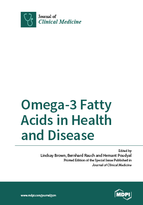Omega-3 Fatty Acids in Health and Disease
A special issue of Journal of Clinical Medicine (ISSN 2077-0383). This special issue belongs to the section "Endocrinology & Metabolism".
Deadline for manuscript submissions: closed (20 November 2015) | Viewed by 185227
Special Issue Editors
Interests: cardiovascular and metabolic pharmacology; functional foods; animal models of chronic human disease
Special Issues, Collections and Topics in MDPI journals
Interests: cardiology in general; cardiovascular prevention; cardiac rehabilitation (specialized); cardiovascular pharmacology of any kind; psychosocial interactions; meta-analyses; hyperlipidemia; hypertension; nutrition; exercise
Interests: endocrinology; nutrition; obesity; diabetes; gut; heart; intestine; incretins; cardiovascular remodeling
Special Issue Information
Dear Colleagues,
The role of the major dietary omega-3 fatty acids (alpha-linolenic acid, eicosapentaenoic acid and docosahexaenoic acid) in human health has generated controversy. The effects of omega-3 fatty acids on cardiometabolic risk factors, such as obesity, insulin resistance, and dyslipidaemia (especially hypertriglyceridaemia) are widely reported in scientific journals, as well as in the mass media. In addition, omega-3 fatty acids are precursors of bioactive metabolites, such as eicosanoids, lipoxins, resolvins, protectins, maresins, and nitrolipids; these metabolites play an important role in physiological processes, such as the regulation of cardiovascular function, the resolution of inflammation, and neuroprotection. Finally, omega-3 fatty acids interfere with cardiac electrophysiology via a variety of mechanisms, thereby potentially mediating cardiac arrhythmias.
This Special Issue of the Journal of Clinical Medicine will emphasize the mechanisms underlying the responses of omega-3 fatty acids with regard to the following important aspects of human health and disease:
- Memory and healthy aging
- Metabolic syndrome risk factors
- Cardiovascular disease
- Neurodegenerative disease
- Bone health
- Cancer
- Inflammation
- Nutrigenomics and nutrigenetics
Prof. Dr. Lindsay Brown
Prof. Dr. Bernhard Rauch
Dr. Hemant Poudyal
Guest Editors
Manuscript Submission Information
Manuscripts should be submitted online at www.mdpi.com by registering and logging in to this website. Once you are registered, click here to go to the submission form. Manuscripts can be submitted until the deadline. All submissions that pass pre-check are peer-reviewed. Accepted papers will be published continuously in the journal (as soon as accepted) and will be listed together on the special issue website. Research articles, review articles as well as short communications are invited. For planned papers, a title and short abstract (about 100 words) can be sent to the Editorial Office for announcement on this website.
Submitted manuscripts should not have been published previously, nor be under consideration for publication elsewhere (except conference proceedings papers). All manuscripts are thoroughly refereed through a single-blind peer-review process. A guide for authors and other relevant information for submission of manuscripts is available on the Instructions for Authors page. Journal of Clinical Medicine is an international peer-reviewed open access semimonthly journal published by MDPI.
Please visit the Instructions for Authors page before submitting a manuscript. The Article Processing Charge (APC) for publication in this open access journal is 2600 CHF (Swiss Francs). Submitted papers should be well formatted and use good English. Authors may use MDPI's English editing service prior to publication or during author revisions.
Keywords
- diabetes
- dyslipidaemia
- obesity
- cardiovascular disease
- cardiac arrhythmias
- schizophrenia
- Alzheimer’s disease
- depression
- rheumatoid arthritis
- inflammation
- cancer









